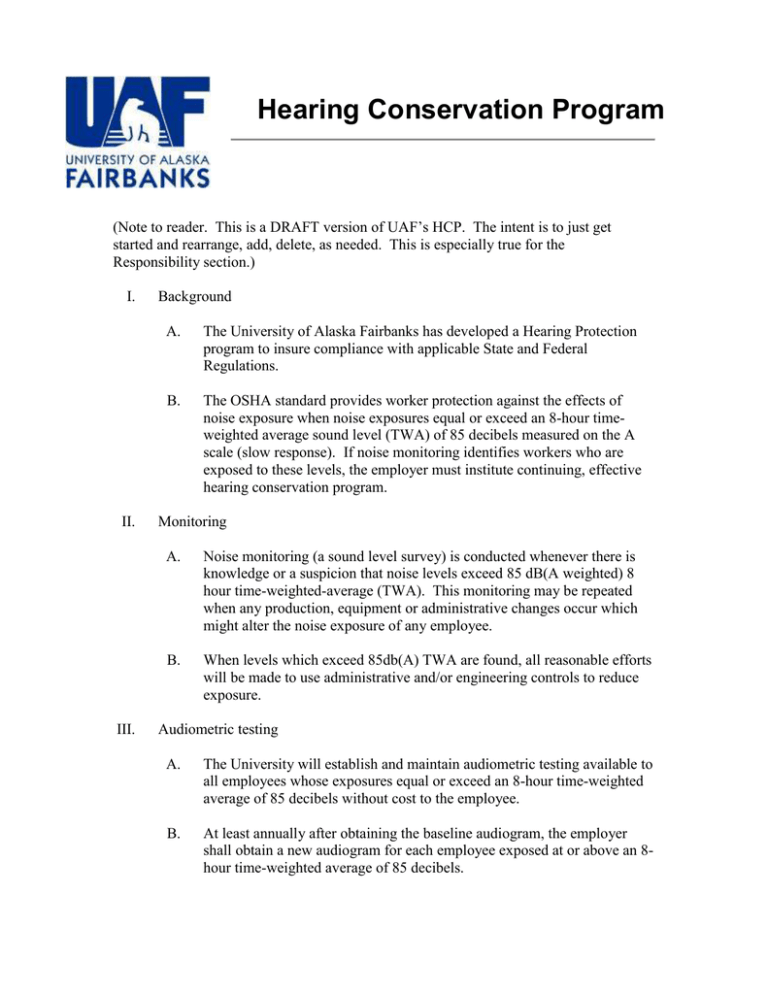Hearing Conservation Program
advertisement

Hearing Conservation Program (Note to reader. This is a DRAFT version of UAF’s HCP. The intent is to just get started and rearrange, add, delete, as needed. This is especially true for the Responsibility section.) I. II. III. Background A. The University of Alaska Fairbanks has developed a Hearing Protection program to insure compliance with applicable State and Federal Regulations. B. The OSHA standard provides worker protection against the effects of noise exposure when noise exposures equal or exceed an 8-hour timeweighted average sound level (TWA) of 85 decibels measured on the A scale (slow response). If noise monitoring identifies workers who are exposed to these levels, the employer must institute continuing, effective hearing conservation program. Monitoring A. Noise monitoring (a sound level survey) is conducted whenever there is knowledge or a suspicion that noise levels exceed 85 dB(A weighted) 8 hour time-weighted-average (TWA). This monitoring may be repeated when any production, equipment or administrative changes occur which might alter the noise exposure of any employee. B. When levels which exceed 85db(A) TWA are found, all reasonable efforts will be made to use administrative and/or engineering controls to reduce exposure. Audiometric testing A. The University will establish and maintain audiometric testing available to all employees whose exposures equal or exceed an 8-hour time-weighted average of 85 decibels without cost to the employee. B. At least annually after obtaining the baseline audiogram, the employer shall obtain a new audiogram for each employee exposed at or above an 8hour time-weighted average of 85 decibels. C. IV. V. VI. VII. Audiometric tests shall be performed by a licensed or certified audiologist. Hearing Protection A. All employees exposed to 85dB(A) TWA noise must have available hearing protectors. It is the supervisor's responsibility to ensure such hearing protectors are worn by employees whose noise exposure equals or exceeds 85dB(A). B. The University will provide training in the use and care of all hearing protectors provided to employees. C. Employees will be encouraged to use UAF’s ear plugs for recreational or other purposes not necessarily associated with UAF. Employee Training Program A. An educational program will be instituted for all employees whose noise exposure exceeds 85dB(A) TWA. B. This program will cover specific topics outlined in 29 CFR 1910.95 and be repeated annually. Recordkeeping A. Records of audiometric testing will be maintained by the health center contracted to perform the audiometric testing. B. Records of exposure measurements and training will be maintained by UAF. Responsibilities A. Environmental Health, Safety, and Risk Management (EHS&RM) assumes responsibility for 1. the overall coordination and implementation of the HCP. This office also assumes responsibility for compliance with OSHA regulations. 2. coordinating efforts to reduce hazardous noise by engineering/administrative controls where feasible. 3. providing training to applicable employees. 4. providing noise surveys on a requested or as needed basis 5. B. C. D. Facilities Services assumes responsibility for 1. providing hearing protectors available to all employees exposed to an 8-hour time-weighted average of 85 decibels or greater at no cost to the employees. Hearing protectors shall be replaced as necessary. 2. notifying current employees of the hearing test requirement and for arranging testing and training. The Department Directors are responsible for 1. compliance withUAF’s Hearing Conservation Program within his/her area of responsibility and to coordinate sound level surveys, hearing testing and training efforts with Codes and Safety. 2. providing EHS&RM with a list of personnel who are exposed to hazardous noise areas and to notify EHS&RM of possible noise hazards which require a survey. First line supervisors 1. E. hearing conservation training either on an individual or group basis. It is the direct responsibility of an employee's first line supervisor to ensure appropriate safety measures are followed. This includes enforcement of hearing protector use where required and accommodation with hearing test requirements Employee 1. Safety is each individual's responsibility. Use of hearing protection where indicated is first and foremost the individual employee's concern. It is also incumbent on each employee to appear for required hearing evaluations, follow instructions regarding noise exposure prior to testing and participate in annual training as directed. 2. UAF employees are also encouraged to use hearing protection while participating in non work related activities such as hunting, boating, and flying.


